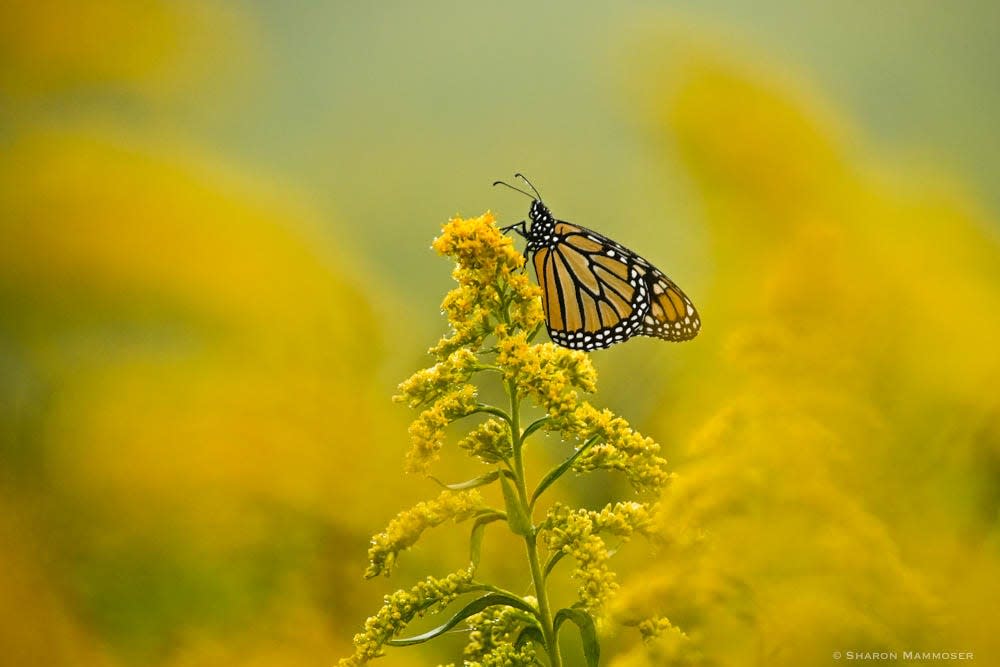Habitat at Home: Goldenrod is glorious fall-blooming flower, powerful pollinator magnet
August is the month when goldenrod starts its glorious show, adding splashes of yellow to fields of green everywhere. In North America, there are over 100 different species of goldenrod, each as brilliant as the next, and each just as much a pollinator magnet. This powerhouse native wildflower in the aster family supports bees, wasps, butterflies, moths, beetles and more. In addition it is the host plant of the wavy-lined emerald moth.
According to Penn State Extension, “Its botanical name, Solidago, is Latin for solidus, meaning "to make whole." This refers to the plant's healing and medicinal properties. It has been used to heal wounds of the skin and to treat inflammation of the mouth and throat, tuberculosis, diabetes, and arthritis. It has diuretic and anti-inflammatory properties. Native Americans have used its leaves as a poultice for bee stings and have made tea with its flowers and leaves to reduce fever. During the American Revolution, goldenrod tea was made as a substitute for British tea.”

Many, many people think goldenrod is responsible for causing hay fever, the seasonal allergy that makes people run indoors and hate fall. However, like many things in nature, this is a myth, as goldenrod has pollen grains that are dense, sticky and large. Goldenrod is pollinated by insects, including 11 specialist native bees that feed solely on goldenrod.
Hay fever is caused by a plant called ragweed. Though goldenrod and ragweed can be found growing together, or in similar places, they are very different. Ragweed is pollinated by the wind. Ragweed pollen is fine and dust-like, for easily moving far distances through the air by the wind. When this ragweed pollen comes into contact with the nasal passages of an allergic person, look out as sneezing, running nose and itchy eyes will ensue. According to Clemson University, "A single ragweed plant is capable of producing over a billion pollen grains." Imagine! No wonder people get terrible allergies from it.
Besides being beautiful, goldenrod is critical for our beloved monarch butterfly as they are passing through on their way to Mexico. Goldenrod offers high-quality pollen that is rich in all the things migrating monarchs require — protein, fats and minerals that will refuel the butterflies on their long journeys south.
Another misconception about goldenrod is that it can’t be put in a home garden or yard because it will take over. While this is true of some species, there are many, many others that behave well and add a fabulous splash of golden color to the landscape when summer flowers have long stopped blooming. Pair it with the purple blooms of one of our native asters or ironweeds and you’ll be treated to a spectacular show for weeks.
Mother Nature does her planting in the fall, and so can you. Fall is a great time for planting, as young plants can establish a strong root system before next spring. With more than 100 species to choose from, I guarantee that there is a species for you. Some species that work well in a container or home garden are:
Canada goldenrod (Solidago canadensis)
Anise-scented goldenrod (Solidago chilensis)
Bluestem goldenrod (Solidago caesia)
Fireworks goldenrod (Solidago rugosa ‘Fireworks’)
Showy goldenrod (Solidago speciosa)
Wrinkleleaf goldenrod (Solidago rugosa)
Old field goldenrod (Solidago nemoralis.)
Whichever species you choose, you can’t go wrong. Enjoy the show, and the marvelous collection of insects that will stop by to visit.
This article is part of Conserving Carolina’s Habitat at Home series, offering seasonal tips to make your home and garden a thriving place for nature.
This article originally appeared on Asheville Citizen Times: Habitat at Home: Goldenrod is glorious fall flower, pollinator magnet
